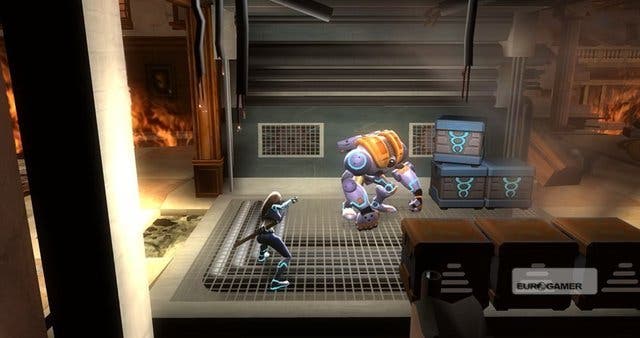Spyborgs
Futile.
Spyborgs looked interesting, once. You might recall that when it was introduced last year, the ex-Insomniac team at start-up studio Bionic Games had a completely different vision to the one in the box today. Designed as a "Saturday morning cartoon-style experience", the plan was to split the game into episodes and include advert breaks, co-op puzzles, comedy gesture-based mini-games and an eclectic array of enemies, comprised of flying crocodiles and poo-covered teddy bears. Yum.
Somewhere along the line, that somewhat-wacky plan got comprehensively ripped up until it was completely unrecognisable. Instead we've got a futuristic co-op beat-'em-up, albeit still featuring three of the things 10-year-old boys love most: stompy robots, a man with a giant hand-cannon strapped to his arm, and a female ninja. Publisher Capcom has been a consistent producer of combo-heavy hackandslash titles over the past decade, and it's apparent from the start that this is an attempt to flog that sort of thing to a younger, more casual audience, even without the poo bears.
Inevitably, there's a silly back-story justifying the presence of the 'Spyborg Initiative'. These elite cybernetic super-soldiers were designed as the nation's first line of defence, but things went awry when they started going missing in action. The game itself kicks off when super-spy Stinger wakes up after a week out cold, having been rescued from the South American jungle after being ambushed and left for dead by former team-mates. Predictably, it's time to hunt down their arses, kick them, kick them again, set fire to them and probably stamp on them as well.
You're given the option to choose two out of three playable characters: the aforementioned stompy robot, Bouncer; a sword-wielding martial arts expert, Clandestine; and a big hunk of manmeat, Stinger, the token shooter-man of this clobberfest. Played either with a human accomplice or an AI assistant, you set about clearing a succession of enclosed environments in the quickest possible time, while racking up the biggest combo count that you can.

The basic game mechanics are evidently designed to be as simple as possible. Movement is assigned to the nunchuk's left stick, while the light and heavy attack are mapped to B and C respectively. Z acts as the block, with A the jump. Simple combos can be strung together with ease, and most of the game involves little more than hammering light or heavy attack, and studiously blocking when, for example, a giant enemy robot crab hoves into view and decides to thwap you in the face repeatedly.
Sadly though, having already littered the environment with crates and boxes to smash, the game then decides to cloak some of them, requiring you to point your Wii remote at the sneaky little item and press A to reveal it. If you ever found this interesting, or it had any puzzle-based implications, it might be fun, but no. Worse though, this 'spy vision' concept extends not only to boxes and crates, but switches and eventually enemies, making gameplay a horribly clumsy mixture of traditional button-mashing hackandslash and remote-waving, with neither faring particularly well once combined.
To add a further layer of unnecessary motion-based flailing to the game, you can also activate finishing moves by holding down Z and swinging the remote if your power gauge is at its maximum. The viewpoint then changes momentarily to frame the action in a stylish slow-motion setting, before flashing up motion-based QTEs in order to smack down on your foe. Fortunately, if the motion control system boils your blood, you can always turn it off completely and revert to buttons. Unfortunately, the gameplay never rises above a repetitive, unengaging trudge in either case.

Elsewhere, the ability to upgrade yourself in a variety of ways might be interesting if you could, for example, unlock different weapons and armour, but Spyborgs also fudges this element. Upgrades are limited to nothing more than new levels of health, damage, skills and your power gauge, and any chance of the game developing a personality of its own is neutered right there.
In technical terms, however, Spyborgs does come out with slightly more credit, thanks to a polished engine and some competent character design and animation. While the endless procession of samey metal gantries provides a tiresomely repetitive futuristic environment to navigate, the developer does at least populate the world with a suitably threatening array of nasties. No doubt a legacy of some of the team's former experience as members of Insomniac, there's a noticeable trace of the Ratchet & Clank games in their visual style, especially the way they explode in a shower of bolts.
It's a shame, then, that despite the experience of working on such a resolutely reliable franchise as Ratchet & Clank, the promised humour and personality that was evident during its first reveal has drained away. Instead, what we've ended up with is a thoroughly generic game with overly simplified beat-'em-up mechanics, extremely repetitive gameplay, and a crushing lack of variety. We'll never know whether fighting poo-covered teddy bears was any more fun than fighting robotic scorpions and giant enemy crabs, but it can't have been much less fun. In its original guise, Spyborgs sounded unhinged but interesting. 18 months later, it's just another rough-and-tumble action game for young boys.








